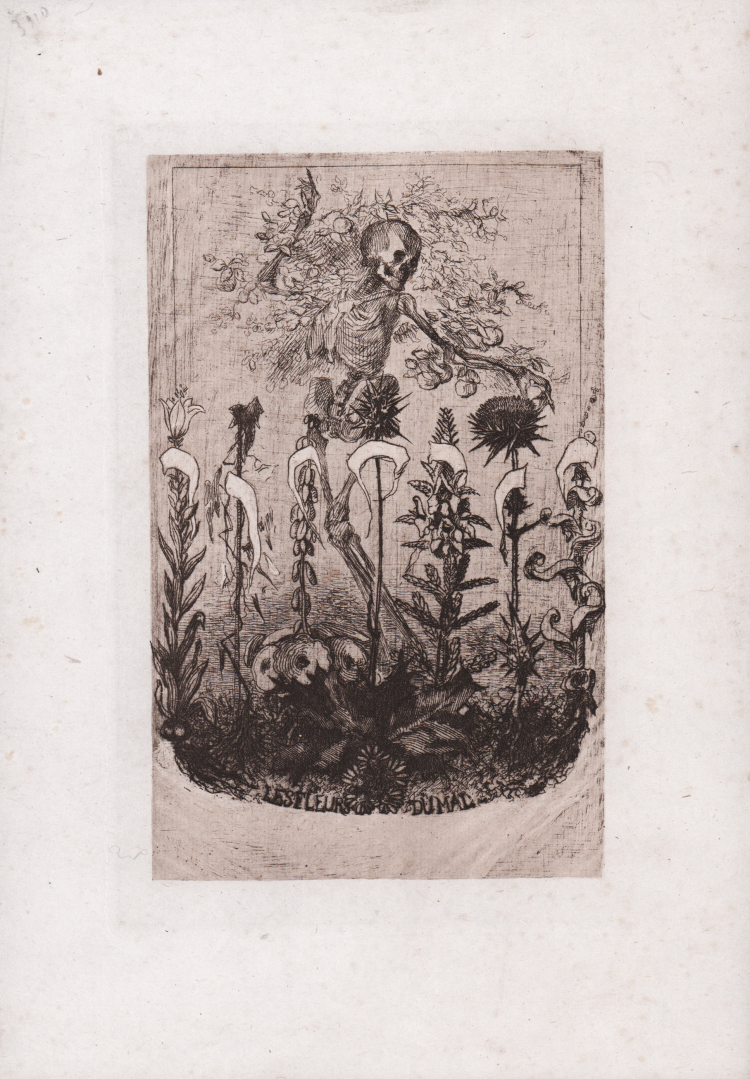



| Reference: | S43547 |
| Author | Felix BRAQUEMOND |
| Year: | 1860 ca. |
| Measures: | 115 x 180 mm |


| Reference: | S43547 |
| Author | Felix BRAQUEMOND |
| Year: | 1860 ca. |
| Measures: | 115 x 180 mm |
Unpublished frontispiece for 'Les Fleurs du Mal' by Baudelaire (1857): a skeleton standing before seven flowers representing the seven deadly sins; his arms extend outwards, enveloped with fruits on branches; the title of the publication at bottom centre.
Etching, 1860 circa, lettered within image at bottom centre: 'LES FLEURS DU MAL'.
A fine impression on contemporary laid paper, with margins, perfect condition.
Example in the first state described by Beraldi.
The most important poetic book of the second half of the 19th century originated as a suite of eighteen poems that appeared in the "Revue des deux mondes" X, 2, May-June 1855. Two years later, in 1857, the first volume edition of the collection, containing one hundred and six poems, underwent a trial from which the poet and publisher emerged convicted, forced, among other things, to censor six poems.
Three years passed, and it was the turn of the final edition; the contract between the publishers and the poet, signed on December 30, 1856, provided for an isseu of 1,000 examples and set the author's compensation at 25 cents for each volume printed, even if unsold. The number of 1,000 examples was not adhered to; in a handwritten note on his copy, the poet indicated a print run of 1,300 volumes, but probably only 1,300 were printed on vélin d' Angouleme, as well as twenty on vélin d' Holland.
The poet had expressed that he would place an allegorical drawing on the frontispiece. The assignment was given to graveur Félix Bracquemond who had already worked for the publisher. According to the poet's wish, the image was to represent an arboreal skeleton rooted in the earth and surrounded by 'flowers of evil.' None of the proofs executed by the 'artist met with Baudelaire's approval, the project was abandoned, and the drawing replaced with a portrait of the author. Bracquemond therefore had to give up his project and limit himself to engraving a portrait of Baudelaire, which would later become one of his most famous and iconic images.
Magnificent proof of this rare work.
Bibliografia
Beraldi 1885-92 / Les Graveurs du dix-neuvième siècle (378.I); IFF / Inventaire du Fonds Français: Bibliothèque Nationale, Département des Estampes (110).
Felix BRAQUEMOND (Parigi 1833 – 1914)
|
Printmaker, designer, painter and writer. From a humble background, he set out on an artistic career after meeting the painter Joseph Guichard, a pupil of Ingres and Delacroix, who was to be his only teacher. He was brought up by a philanthropist friend of Auguste Comte, Dr Horace de Montègre, whose portrait he drew in pastel in 1860 (Paris, Mus. d’Orsay). Comte’s positivist philosophy was a considerable influence on Bracquemond’s aesthetic ideas. From 1852 he exhibited at the Salon both drawn and painted portraits in the style of Ingres, for example Mme Paul Meurice (Compiègne, Château), but he gave up painting after 1869.
|
Felix BRAQUEMOND (Parigi 1833 – 1914)
|
Printmaker, designer, painter and writer. From a humble background, he set out on an artistic career after meeting the painter Joseph Guichard, a pupil of Ingres and Delacroix, who was to be his only teacher. He was brought up by a philanthropist friend of Auguste Comte, Dr Horace de Montègre, whose portrait he drew in pastel in 1860 (Paris, Mus. d’Orsay). Comte’s positivist philosophy was a considerable influence on Bracquemond’s aesthetic ideas. From 1852 he exhibited at the Salon both drawn and painted portraits in the style of Ingres, for example Mme Paul Meurice (Compiègne, Château), but he gave up painting after 1869.
|